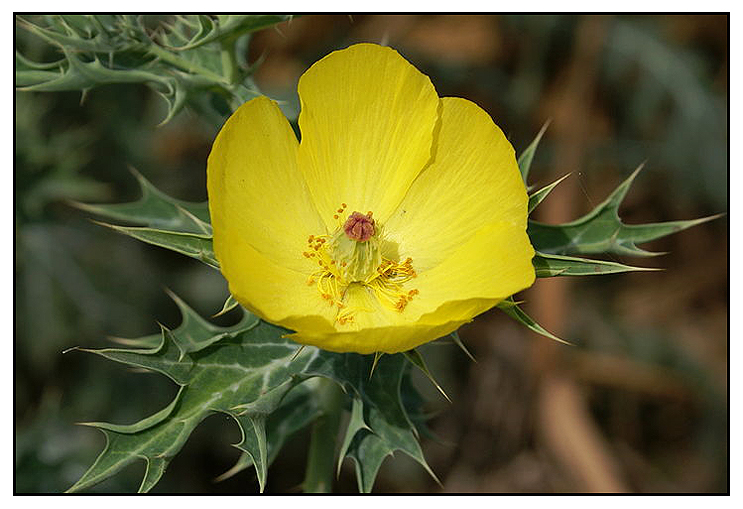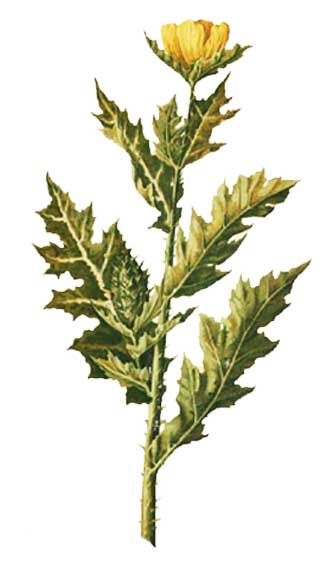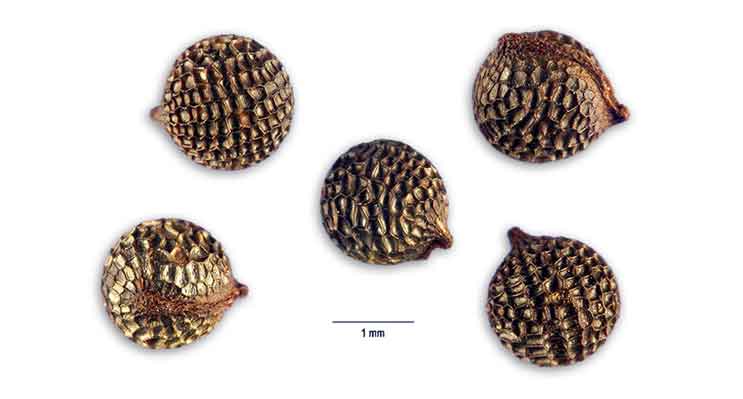
Family • Papaveraceae
Kachumba
Argemone mexicana Linn.
PRICKLY POPPY
Lao chou
| Scientific names | Common names |
| Argemone alba Raf. [Illegitimate] | Baruas (Iv.) |
| Argemone mexicana Linn. | Diluariu (Tag.) |
| Argemone mucronata Dum.Cours. ex Steud. | Kachumba (Ilk.) |
| Argemone sexvalvis Stokes | Kagang-kagang (C. Bis.) |
| Argemone spinosa Gaterau | Kasubhag-aso (Ilk.) |
| Argemone spinosa Moench | Kasubang-aso (Ilk.) |
| Argemone versicolor Salisb. | Bird-in-the-bush (Engl.) |
| Argemone vulgaris Spach | Goatweed (Engl.) |
| Echtrus mexicanus (L.) Nieuwl. | Golden thistle of Peru (Engl.) |
| Echtrus trivialis Lour. | Mexican poppy (Engl.) |
| Papaver mexicanum (L.) E.H.L.Krause | Prickly poppy (Engl.) |
| Queen thistle (Engl.) | |
| Diluariu is a common name shared by: (1) Diluario, Acanthus ilicifolius, and (2) Kachumba, Argemone mexicana | |
| Argemone mexicana L. is an accepted name The PLant List | |
| Other vernacular names |
| BANGLA: Shialkanta. |
| CHINESE: Ji ying su, Ci ying su. |
| GUJRATI: Darudi. |
| HINDI: Shialkanta, Satyanashi. |
| MALAYALAM: Ponnummattu, Kantankattiri. |
| MARATHI: Daruri, Firangi-kote-pavola, Dhotara. |
| SANSKRIT: Brahmadandi, Pitopushpa, Srigalkanta, Svarnakshiri. |
| TAMIL: Kuttiyotti, Ponnummuttai. |
| TELUGU: Brahmadandicettu. |
| OTHERS: Ghamoya. |
Updated November 2020 / February 2017 /December 2015
![]()
 |
| PHOTOS / ILLUSTRATIONS |
| IMAGE SOURCE: Photograph / Flower of Mexican Poppy (Argemone mexicana), an introduced weed on Réunion island / :Argemone mexicana 02.jpg / Photo by B. Navez / CC BY-SA 3.0. / click on image to go to source page / Wikipedia |
| OTHER IMAGE SOURCE: Public Domain / File:Argemone mexicana Blanco1.187-original.png / Flora de Filipinas / Francisco Manuel Blanco (O.S.A.) / 1880-1883 / Wikimedia Commons |
| OTHER IMAGE SOURCE: Seeds /Argemone mexicana L. - Mexican pricklypoppy ARME4/ Steve Hurst @ USDA-NRCS PLANTS Database / USDA |
| Additional
Sources and Suggested Readings (1) Argemone mexicana - Prickly Poppy / - K. Edley (2) Antibacterial potentiality of Argemone mexicana solvent extracts against some pathogenic bacteria / Indranil Bhattacharjee et al / Mem. Inst. Oswaldo Cruz vol.101 no.6 Rio de Janeiro Sept. 2006 / doi: 10.1590/S0074-02762006000600011 (3) Argemone Mexicana Linn. (Ghamoya) : A Weed Having Great Therapeutic Values In Folk Remedies / Sumeet Dwivedi / Pharmainfo.net (4) TOXICITY OF ARGEMONE MEXICANA SEED, SEED OIL AND THEIR EXTRACTS ON ALBINO RATS / A A El Gamal, O S A Mohamed and S A Khalid. (5) Epidemic dropsy following transcutaneous absorption of Argemone mexicana oil / N N Sood, Mahipal Sachdev et al / Tropical Medicine & Hygiene, Volume 79, Issue 4, Pages 510-512 (1985) (6) In vitro Antibacterial Screening and Toxicity Study of Some Different Medicinal Plants / Rajib Ahsan, Monirul Islam et al / World Journal of Agricultural Sciences 5(5):617-621,2009 (7) Argemone mexicana decoction versus artesunate-amodiaquine for the management of malaria in Mali: policy and public-health implications / Bertrand Graz, Merlin Willcox et al / Transactions of the Royal Society of Tropical Medicine and Hygiene (8) Different Effects of Some Isoquinoline Alkaloids from Argemone mexicana on Electrically Induced Contractions of Isolated Guinea-pig Ileum / Sonia Piacente, Anna Capasso et al / Phytotherapy Research Volume 11, Issue 2, pages 155–157, March 1997 / DOI: 10.1002/(SICI)1099-1573(199703)11:2<155::AID-PTR48>3.0.CO;2-9 (9) Phytochemical Screening And Toxicity Evaluation On The Leaves of Argemone Mexicana Linn (Papaveraceae) / H A Ibrahim and H Ibrahim / Int. Jor. P. App. Scs., 3(2):39-43, 2009 (10) Anti-Stress and Antiallergic Effect of Argemone Mexicana Stems in Asthma / R D Bhalke and S A Gosavi / Arch Pharm Sci & Res Vol 1 No 1 127 - 129 October 2009 (11) Studies On the Neurotoxicology Of Argemone oil / Almas Siddiqui / Medical Elementology & Toxicology, Faculty of Science, 2002 (12) Argemone mexicana L. (accepted name) / Chinese names / Catalogue of Life, China (13) Bacteriostatic potential of Argemone mexicana Linn. against enteropathogenic bacteria / Vivek Kempraj and Sumangala K Bhat / Indian Journ of Natural Products and Resources, Vol 1(3), Sept 2010, pp 338-341 (14) Evaluation of Argemone mexicana Linn. Leaves for wound healing activity / G. K. Dash* and P. N. Murthy / J. Nat. Prod. Plant Resour., 2011, 1 (1): 46-56 (15) STUDY ON REPELLENT ACTIVITY OF ARGEMONE MEXICANA ON TRIBOLIUM CASTANEUM AND SITOPHILUS ORYZAE / Abdul Majeed S*, Abidunnisa T / IJPRD, May - 2011, Vol 3, No 3 (16) PHARMACOLOGICAL SCREENING EFFECT OF ETHANOLIC AND METHANOLIC EXTRACT OF FRUITS OF MEDICINALLY LEAVES / SMITA SHARMA, MUKESH. CHANDRA. SHARMA*, D.V.KOHLI / Digest Journal of Nanomaterials and Biostructures Vol. 5, No 1, March 2010, p. 229 – 232 (17) PHYTOCHEMICAL SCREENING OF SECONDARY METABOLITES OF ARGEMONE MEXICANA LINN. FLOWERS / NUPUR JOSHI*, SHASHANK BHATT*, DR. SURESH DHYANI*, JYOTI NAIN / International Journal of Current Pharmaceutical Research, Vol 5, Issue 2, 2013 (18) Cytotoxic Benzophenanthridine and Benzylisoquinoline Alkaloids from Argemone mexicana / Yuh-Chwen Chang, Fang-Rong Chang, Ashraf T. Khalil, Pei-Wen Hsieh, and Yang-Chang Wu* / Z. Naturforsch. 58c, 521Ð526 (2003) (19) Evaluation of antibacterial and antioxidant activity of fruits extract of Argemone mexicana Linn. / Rahi Ashish Jain *, R.C. Agarwal, Dayanand Dubey, Rahul Verma, Roshan Jain / International Journal of Pharmaceutical Innovations, Volume 2, Issue 1, January− February 2012 (20) Neuropharmacological study of Argemone mexicana Linn. / Sneha Anarthe and Sanjay Chaudhari / Journal of Applied Pharmaceutical Science, 2011; 01(04): pp 121-126 (21) Biodiesel production from Argemone mexicana seed oil using crystalline manganese carbonate / Rajeshwer Rao, Pudukulathan Zubaidha, Dasharath Kondhare, Narender Reddy, Sushma Deshmukh / Polish Journal of Chemical Technology. Volume 14, Issue 1, Pages 65–70 / DOI: 10.2478/v10026-012-0061-x, April 2012 (22) in-vitro Anti-Cancer activity of Methanolic extract of leaves of Argemone mexicana Linn. / Kiranmayi.Gali*, G. Ramakrishnan, R. Kothai, B. Jaykar / Int.J. PharmTech Res., 2011; 3(3): pp 1329-1333 / ISSN: 0974-4304 (23) Epidemic dropsy following transcutaneous absorption of Argemone mexicana oil. / Sood NN, Sachdev MS, Mohan M, Gupta SK, Sachdev HP. / Trans R Soc Trop Med Hyg. 1985; 79(4): pp 510-512. (24) Argemone mexicana L. / Synonyms / The Plant List (25) Pharmacological efficacy of argemone mexicana plant extract, against cysteamine-induced duodenal ulceration in rats / Prabhat K Das, Sujit Pillai, Durga Kar, Debasish Pradhan, Sabuj Sahoo / Indian Journal of Medical Sciences, 2011; Vol 65, Issue 3: pp 92-99 / doi: 10.4103/0019-5359.104788. (26) Biological evaluation of anti-inflammatory and analgesic activities of Argemone mexicana Linn. (Papaveraceae) aqueous leaf extract / SOURABIE T.S., N. OUEDRAOGO, W.R. SAWADOGO, J.B. NIKIEMA, I.P. GUISSOU, and O. G. NACOULMA / International Journal of Pharma Sciences and Research (IJPSR) / Sept 2012; 3(9): pp 451-458 / ISSN: 0975-9492 (27) ANTIMICROBIAL POTENTIAL OF ARGEMONE MEXICANA: AN IN VITRO STUDY / MANJU BHARDWAJ, JOGINDER S. DUHAN, ASHOK KUMAR AND SUREKHA / Asian Journal of Microbiology, Biotechnology & Environmental Sciences Paper, Vol 14, Issue 2, 2012; Pp 353-357. (28) Argemone mexicana Leaf Extract for Inhibition of Mild Steel Corrosion in Sulfuric Acid Solutions / Gopal Ji, Sudhish Kumar Shukla, Eno E. Ebenso, Rajiv Prakash* / Int. J. Electrochem. Sci., 8 (2013) 10878 - 10889 (29) In vitro anthelmintic activity of aerial parts of Argemone mexicana Linn / Jaliwala, Y. A.; Panda, P. K.; Neha, Chourasia; Kumar, Bhatt Neeraj; Amit, Pandit; Mohanty, P. K. / Journal of Pharmacy Research; Sept 2011, Vol. 4 Issue 9, p 3173 (30) Invitro Antioxidant Activity of Argemone mexicana Roots / Perumal P*, Sekar V, Rajesh V, Gandhimathi S, Sampathkumar R, Shuja Nazimudin K.H / International Journal of PharmTech Research, IVol.2, No.2, pp 1477-1482, April-June 2010 (31) HYPOGLYCAEMIC ACTIVITY OF AERIAL PARTS OF ARGEMONE MEXICANA L. IN EXPERIMENTAL RAT MODELS / S. P. ROUT *, D. M. KAR, P. K. MANDAL / International Journal of Pharmacy and Pharmaceutical Sciences, Vol 3, Suppl 5, 2011 (32) Oviposition altering and ovicidal efficacy of root extracts of Argemone mexicana against dengue vector, Aedes aegypti (Diptera: Culicidae) / Radhika Warikoo and Sarita Kumar / Journal of Entomology and Zoology Studies 2014; 2 (4): 11-17 (33) Cytotoxicity of alkaloids isolated from Argemone mexicana on SW480 human colon cancer cell line / Sarita Singh, Mradul Verma, Meenakshi Malhotra, Satya Prakash & Tryambak Deo Singh* / Pharmaceutical Biology / DOI:10.3109/13880209.2015.1073334 (34) Immuno Modulatory Effects of Hot Aqueous Extract of Ocimum sanctum and Argemone mexicana Leaves in Chicken Model / Puneet Varshney , Sandeep Kumar Dash , Anjana Goel , Ashok Kumar Bhatia / Medicinal Plant Research, 2013, Vol. 3, No. 8 doi: 10.5376/mpr.2013.03.0008 (35) Gold Nanoparticles of Argemone mexicana Induces Oxidative Stress and Inhibits Cell Growth In MCF-7 Cells / Varun S, Sudha S* / International Journal of Toxicological and Pharmacological Research (36) Argemone mexicana-Prickly Poppy / Entheology.com (37) Medicinal weed Satyanashi (Argemone mexicana Linn) / Common Indian Names / Pankaj Oudhia / Hort.Perdue.com (38) Phytochemical Screening & in vitro Antioxidant and Thrombolytic Activities of Argemone mexicana Extracts / Ahamed Hasan Al-Baizyd / In Partial Fulfillment of the Requirements for the Award of the Degree Bachelor of Pharmacy / July 2012 (39) Antibiotic Effects of Argemone mexicana (Papaveraceae) against Field Crops and Pathogens Causing Mastitis in Dairy Cattle in three Districts of Amhara Region, Ethiopia / Kefyalew Alemayehu* and Tadesse Desalegn / Journal of Advances in Biology & Biotechnology 5(1): 1-9, 2016 (40) Effect of Argemone mexicana (L.) against lithium-pilocarpine induced status epilepticus and oxidative stress in wistar rats / G Asuntha, Y rasanna Raju, CR Sundaresan, Arun Rasheed, V Harini Chowdary, KR Vandana, K Satish Babu and KVSRG Prasad / Indian Journal of Experimental Biology, Vol 53, Jan 2015 (41) Antifungal and Anticancer Potential of Argemone mexicana L. / Nilesh V. More, and Arun S. Kharat * / Medicines 2016, 3, 28 / doi:10.3390/medicines3040028 (42) Pharmaceutical applications of the benzylisoquinoline alkaloids from Argemone mexicana L. / Rubio-Pina J, Vazquez-Flota F. / Curr Top Med Chem. 2013;13(17): pp 2200-2207. (43) (44) Kasubhag-aso / T H Pardo de Tavera / The Project Guttenberg Book of the Medicinal Plants of the PHilippines / Tanslator: Jerome Beers Thomas / eBook: 26393 (45) Argemone mexicana: chemical and pharmacological aspects / Goutam Brahmachari, Dlip Gorai, Rajiv Roy / Revosta Brasileira de Farmacognosia, May/June 2013; 23(3) / ISSN: 0102-695X (46) Comparative Study of the Antiurolithiatic Activity of Plant Hydroalcoholic Extract of Argemone mexicana, Cissus javana DC and Garcinia pendunculata / O Ibopishak Singh, A Bimola Devi / International Journal of Science and Research, May 2016; 5(5): pp 2066-2070 (47) Analgesic and Anti-Inflammatory Studies on the Roots of Argemone mexicana Linn (Family: Papaveraceae) / H A Ibrahim, Mahmud Ali Umar, Bilkisu A Bello, Abdulazeez Aliyu and Abdulazeez Ahmad / IOSR Journal of Pharmacy and Biological Sciencesm Nay-June 2016; 11(3) Ver IV: pp 92-95 /eISSN: 2278-3008 (48) Effect by Ingestion of Extracts of Argemone mexicana L. on Biological Parameters and Capability of Chrysoperla carnea (Stephens) to Increase in a Laboratory / Miguel Aragon Sanchez, Carlos Serratos-Tejeda, Samuel Pineda et al / Southweztern Entomologist, 2020; 45(2): pp405-414 / https://doi.org/10.3958/059.045.0209 (49) Evaluation of diuretic and laxative activity of aqueous extract of Argemone mexicana leaves in rats / Bairagi Shripad Motilal, Inayat B Pathan, Nema Nitin / Ars Pharmaceutica, 2017; 58)(2): pp 53-58 (50) Phytopharmacognostical Evaluation of Argemone mexicana L. Seeds / Sreya Dutta, Kalyan Hazra, Mruthyumjaya Meda Rao / Journal of Pharmacognosy and Phytochemistry, 2018; 7(6): pp 1507-151 |
DOI |
• |
| List of Understudied Philippine Medicinal Plants |
 |


 istribution
istribution Uses
Uses 